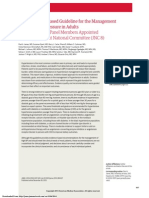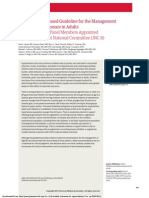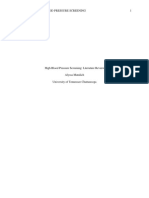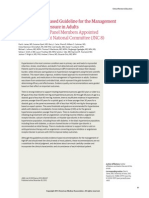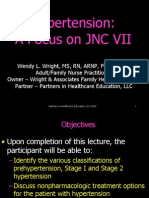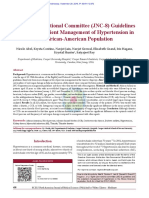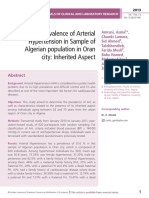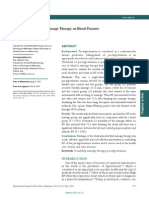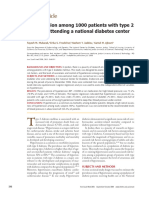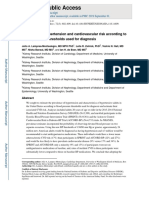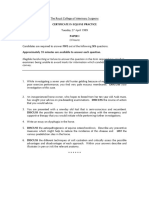Primary Prevention of Hypertension
Primary Prevention of Hypertension
Uploaded by
cinthyaaaCopyright:
Available Formats
Primary Prevention of Hypertension
Primary Prevention of Hypertension
Uploaded by
cinthyaaaOriginal Title
Copyright
Available Formats
Share this document
Did you find this document useful?
Is this content inappropriate?
Copyright:
Available Formats
Primary Prevention of Hypertension
Primary Prevention of Hypertension
Uploaded by
cinthyaaaCopyright:
Available Formats
SPECIAL COMMUNICATION
Primary Prevention of Hypertension
Clinical and Public Health Advisory From
the National High Blood Pressure Education Program
Paul K. Whelton, MD, MSc
Jiang He, MD, PhD
Lawrence J. Appel, MD, MPH
Jeffrey A. Cutler, MD, MPH
Stephen Havas, MD, MPH, MS
Theodore A. Kotchen, MD
Edward J. Roccella, PhD, MPH
Ron Stout, MD, MPH
Carlos Vallbona, MD
Mary C. Winston, EdD, RD
Joanne Karimbakas, MS, RD
for the National High Blood Pressure
Education Program Coordinating
Committee
DIRECT POSITIVE RELATION-
ship between blood pressure and cardiovascular risk
has long been recognized.
This relationship is strong, continuous, graded, consistent, independent,
predictive, and etiologically significant for those with and without coronary heart disease1,2; it has been identified in both men and women, younger
and older adults, different racial and
ethnic groups, different countries; and
applies to those with high-normal blood
pressure as well as those with hypertension.1,3
Despite progress in prevention,
detection, treatment, and control of
high blood pressure, hypertension
remains an important public health
problem. Based on the Third National
Health and Nutrition Examination
1882
The National High Blood Pressure Education Program Coordinating Committee published its first statement on the primary prevention of hypertension in
1993. This article updates the 1993 report, using new and further evidence
from the scientific literature. Current recommendations for primary prevention of hypertension involve a population-based approach and an intensive
targeted strategy focused on individuals at high risk for hypertension. These
2 strategies are complementary and emphasize 6 approaches with proven efficacy for prevention of hypertension: engage in moderate physical activity;
maintain normal body weight; limit alcohol consumption; reduce sodium intake; maintain adequate intake of potassium; and consume a diet rich in fruits,
vegetables, and low-fat dairy products and reduced in saturated and total fat.
Applying these approaches to the general population as a component of public health and clinical practice can help prevent blood pressure from increasing and can help decrease elevated blood pressure levels for those with high
normal blood pressure or hypertension.
www.jama.com
JAMA. 2002;288:1882-1888
Survey (NHANES III), approximately
43 million noninstitutionalized US
adults, 18 years of age or older, met
the criteria for diagnosis of hypertension (systolic blood pressure 140
mm Hg or diastolic blood pressure
90 mm Hg, or taking antihypertensive medication) recommended in The
Sixth Report of the Joint National Committee on Prevention, Detection, Evaluation, and Treatment of High Blood Pressure (JNC VI).4-6 Almost 13 million
additional persons had been diagnosed as having hypertension by a
health care professional but did not
meet the previously mentioned JNC
Author Affiliations: Department of Epidemiology and
Medicine, Tulane University Health Sciences Center
(Dr Whelton) and Department of Epidemiology, School
of Public Health and Tropical Medicine (Dr He), Tulane University, New Orleans, La; Departments of Internal Medicine, Epidemiology, and International
Health, Johns Hopkins Medical Institutions, Baltimore, Md (Dr Appel); Division of Epidemiology and
Clinical Applications (Dr Cutler) and National High
Blood Pressure Education Program, Office of Prevention, Education, and Control (Dr Roccella), National
Heart, Lung, and Blood Institute, National Institutes
of Health, Bethesda, Md; Department of Epidemiology and Preventive Medicine, University of Maryland School of Medicine, Baltimore (Dr Havas);
Department of Medicine, Division of Endocrinology,
Metabolism and Clinical Nutrition, Medical College of
Wisconsin, Milwaukee (Dr Kotchen); Health Care Research Center, The Procter and Gamble Company, Mason, Ohio (Dr Stout); Department of Family and Community Medicine, Baylor College of Medicine, Houston,
Tex (Dr Vallbona); American Heart Association, Dallas, Tex (Dr Winston); and American Institutes for
Research Health Program, Silver Spring, Md (Ms
Karimbakas).
Corresponding Author and Reprints: Edward J. Roccella, PhD, MPH, Coordinator, National High Blood Pressure Education Program, National Heart, Lung, and
Blood Institute/NIH, 31 Center Dr, MSC 2480, Bethesda,
MD 20892-2480 (e-mail: roccella@nih.gov).
JAMA, October 16, 2002Vol 288, No. 15 (Reprinted)
Downloaded From: http://jama.jamanetwork.com/ on 12/07/2014
2002 American Medical Association. All rights reserved.
PRIMARY PREVENTION OF HYPERTENSION
VI criteria.4 Approximately 20 million
of the estimated 43 million persons
with hypertension were not being
treated with antihypertensive medication, and almost 12 million of the
nearly 23 million for whom such
medication was being prescribed had
inadequately controlled hypertension. 4 More than 23 million adults
had high-normal blood pressure (130139 mm Hg systolic or 85-89 mm Hg
diastolic), and almost 38 million had
normal but above optimal blood pressure levels (120-129 mm Hg systolic
or 80-84 mm Hg diastolic).
Primary prevention of hypertension provides an opportunity to interrupt and prevent the continuing costly
cycle of managing hypertension and its
complications.7 The purpose of this article is to update the 1993 National High
Blood Pressure Education Program Working Group Report on Primary Prevention of Hypertension7 and to address the
public health challenges of hypertension described in the JNC VI report.6
METHOD OF GUIDELINE
DEVELOPMENT
The National High Blood Pressure Education Program (NHBPEP) Coordinating Committee consists of representatives from 38 national professional,
public, and voluntary health organizations and 7 federal agencies. As part of
the mission to translate research results into practice, the NHBPEP Committee develops guidelines, advisories, and statements for the clinical and
public health communities. Since the
first statement on the primary prevention of hypertension was published in
1993,7 new and further evidence supporting those recommendations has
emerged.
The National Heart, Lung, and Blood
Institute (NHLBI) staff identified research suggesting the need to update the
NHBPEP 1993 report. The chair of the
Coordinating Committee appointed cochairs and additional members to serve
as a working group on behalf of the Coordinating Committee. To assist the cochairs, NHLBI staff conducted a
MEDLINE search of the English-
language, peer-reviewed scientific literature from 1993 through 2001 using
key Medical Subject Headings (MeSH)
terms hypertension, blood pressure, primary prevention, exercise, weight loss, alcohol drinking, diet sodium-restricted, dietary potassium, and diet.
The co-chairs reviewed the
MEDLINE search results, identified new
areas to be addressed, and, with the assistance of NHLBI staff, developed an
outline and subsequently assembled a
working draft of the document. The
draft document was distributed to the
members of the working group for additions and modifications. Thereafter,
the additions and modifications were
tabulated and discussed via teleconferencing and electronic mail. This process continued among members of the
working group, NHLBI staff, and cochairs in a reiterative fashion. The cochairs adjudicated differences of opinions. The assembled document was
mailed to the working group members for their final comments. The cochairs then revised the document and
forwarded it to the entire Coordinating Committee for review and comment. A working group member presented the report to the entire NHBPEP
Coordinating Committee at its February 2002 meeting, and they provided
oral and written comments to be included in the document. Two meetings of NHLBI staff and the co-chairs
were held to address and incorporate
the Coordinating Committee comments. Thereafter, the penultimate draft
of the report was prepared and sent to
the Coordinating Committee who
unanimously voted to approve it.
The development of this report was
funded entirely by the NHLBI. The
members of the working group, Coordinating Committee, and reviewers
served as volunteers.
Evidence Classification
The studies that provided evidence supporting the recommendations of this report were classified and reviewed by the
staff, co-chairs, and working group
members. The scheme used for classification of the evidence is adapted from
2002 American Medical Association. All rights reserved.
Downloaded From: http://jama.jamanetwork.com/ on 12/07/2014
Last and Abramson8 and has been used
previously.6 (See boxed note before Reference List for the classification scheme.)
LIFETIME BURDEN OF
ELEVATED BLOOD PRESSURE
Age-related increase in blood pressure
is a typical occurrence in most but not
all populations. Accordingly, the prevalence of hypertension increases with
increasing age, such that more than 1 of
every 2 adults older than 60 years of age
has hypertension.4 Experience in the
Framingham Heart Study suggests that
the residual lifetime risk for hypertension is 90%, and the probability of receiving antihypertensive medication is 60%
for middle-aged and elderly individuals.9 High blood pressure increases morbidity and mortality from coronary heart
disease, stroke, congestive heart failure, and end-stage renal disease.1,10,11
There is no convincing evidence of a
J-shaped relationship or a threshold
below which the relationship between
level of blood pressure and risk of cardiovascular and renal disease is not
observed.12 The association of systolic
blood pressure with risk of cardiovascular and renal disease is stronger than
the corresponding relationship for diastolic blood pressure.13 In light of such
knowledge, this advisory is primarily
focused on systolic blood pressure.
High blood pressure is only one of
several proven major modifiable risk
factors for cardiovascular disease. In
combination, these factors provide a
powerful basis for predicting risk and
preventing cardiovascular complications in the general population. A
recent report of large cohort studies conducted in 366559 young and middleaged men and women indicated that
persons with a low cardiovascular disease-risk profile (serum cholesterol level
200 mg/dL [5.18 mmol/L], blood
pressure 120/80 mm Hg, and no current cigarette smoking) have a 72% to
85% lower mortality from cardiovascular disease and a 40% to 58% lower
mortality from all causes compared with
persons who have 1 or more of 3 modifiable cardiovascular risk factors.14 The
estimated greater life expectancy for the
(Reprinted) JAMA, October 16, 2002Vol 288, No. 15 1883
PRIMARY PREVENTION OF HYPERTENSION
Prevalence, %
Figure. Systolic Blood Pressure Distributions
After
Intervention
Before
Intervention
Reduction in BP
Blood Pressure, mm Hg
Reduction in BP,
mm Hg
2
3
5
% Reduction in Mortality
Stroke
CHD
Total
6
8
14
4
5
9
3
4
7
BP indicates blood pressure; CHD, coronary heart disease. Adapted from Arch Intern Med,7 with additional data from Stamler.16
low-risk group ranged from 5.8 to 9.5
years. Computer programs and riskcalculating charts are available to assist clinicians and public health workers in determining risk (http://www
.nhlbi.nih.gov).15
RECOMMENDATIONS
Approaches to Primary Prevention
of Hypertension
Hypertension can be prevented by
complementary application of strategies that target the general population
and individuals and groups at higher risk
for high blood pressure. Lifestyle interventions are more likely to be successful, and the absolute reductions in risk
of hypertension are likely to be greater
when targeted in persons who are older
and those who have a higher risk of developing hypertension compared with
their counterparts who are younger or
have a lower risk. However, prevention strategies applied early in life provide the greatest long-term potential for
avoiding the precursors that lead to hypertension and elevated blood pressure levels and for reducing the overall
burden of blood pressurerelated complications in the community.
Population-Based Strategy
A population-based approach aimed at
achieving a downward shift in the distribution of blood pressure in the general population is an important component for any comprehensive plan to
prevent hypertension. As shown in the
FIGURE, a small decrement in the dis1884
tribution of systolic blood pressure is
likely to result in a substantial reduction in the burden of blood pressure
related illness.16 In an analysis based on
Framingham Heart Study experience,
Cook et al17 reported that a 2-mm Hg reduction in the population average of diastolic blood pressure for white US residents 35 to 64 years of age would result
in a 17% decrease in the prevalence of
hypertension, a 14% reduction in the
risk of stroke and transient ischemic attacks, and a 6% reduction in the risk of
coronary heart disease. Public health approaches, such as lowering sodium content or caloric density in the food supply, and providing attractive, safe, and
convenient opportunities for exercise are
ideal population-based approaches for
reduction of average blood pressure in
the community. Enhancing access to appropriate facilities (parks, walking trails,
bike paths) and to effective behavior
change models is a useful strategy for increasing physical activity in the general population.18
Intensive Targeted Strategy
More intensive targeted approaches,
aimed at achieving a greater reduction
in blood pressure in those who are most
likely to develop hypertension, complement the previously mentioned population-based strategies for prevention of
hypertension. Groups at high risk for
hypertension include those with highnormal blood pressure, a family history of hypertension, African American (black) ancestry, overweight or obesity, a sedentary lifestyle, excess intake
of dietary sodium, insufficient intake of
potassium, or excess consumption of
alcohol. Contexts in which intensive
targeted interventions can be conducted to prevent hypertension in African Americans and older Americans
include health care settings as well as
senior centers and faith-based organizations that have blood pressure screening and referral programs.
Interventions With
Documented Efficacy
The 1993 recommendations 7 included weight loss, reduced intake of
JAMA, October 16, 2002Vol 288, No. 15 (Reprinted)
Downloaded From: http://jama.jamanetwork.com/ on 12/07/2014
dietary sodium, moderation in alcohol consumption, and increased physical activity as the best proven interventions for prevention of hypertension.
Since then, further evidence in support of these recommendations has
emerged. In addition, potassium
supplementation and modification of
eating patterns has been shown to be
beneficial in prevention of hypertension. Brief descriptions of the 6 recommended lifestyles with proven efficacy for prevention of hypertension are
presented in the BOX. A summary of selected intervention efficacy experience published since 1993 is presented in the following sections.
Weight Loss. A comprehensive review of the evidence supporting the value
of modest reductions in body weight is
provided in the Clinical Guidelines for the
Identification, Evaluation, and Treatment of Overweight and Obesity in Adults.19
He et al20 reported on the experience of
181 normotensive persons who had participated in phase I of the Trials of Hypertension Prevention. During their initial 18 months of active intervention,
those assigned to the weight loss group
reduced their body weight by 7.7 lb (3.5
kg) and their systolic and diastolic blood
pressures by 5.8 and 3.2 mm Hg, respectively. After 7 years of follow-up, the incidence of hypertension was 18.9% in the
weight loss group and 40.5% in the control group. These findings suggest that
weight loss interventions produce benefits that persist long after the cessation
of the active intervention. In phase II of
the Trials of Hypertension Prevention,
the 595 participants assigned to a weight
loss counseling intervention experienced a 21% reduction in hypertension
incidence compared with 596 counterparts assigned to usual care.21 Weight loss
participants who were able to lose 9.7 lb
(4.4 kg) or more and to sustain this
weight loss through the 36-month period of follow-up experienced average reduction in systolic and diastolic blood
pressure of 5.0 and 7.0 mm Hg, respectively.22
Dietary Sodium Reduction. At
least 3 meta-analyses23-25 of the efficacy
of reduced sodium intake in lowering
2002 American Medical Association. All rights reserved.
PRIMARY PREVENTION OF HYPERTENSION
blood pressure have been published
since 1993. In all 3 reports, sodium
reduction was associated with a small
but significant reduction in systolic
blood pressure in normotensive persons. In a meta-analysis of 12 randomized controlled trials conducted in
1689 normotensive participants, Cutler et al23 estimated that an average
reduction of 77 mmol/d in dietary
intake of sodium resulted in a 1.9mm Hg (95% confidence interval [CI],
1.2-2.6 mm Hg) decrement in systolic
blood pressure and a 1.1-mm Hg (95%
CI, 0.6-1.6 mm Hg) decline in diastolic blood pressure.
In a randomized controlled trial (the
Dietary Approaches to Stop Hypertension [DASH]-Sodium Trial) conducted in 412 persons with an average
systolic blood pressure of 120 to 159
mm Hg and an average diastolic blood
pressure of 80 to 95 mm Hg, a reduction in sodium intake from a high level
(mean urinary sodium excretion, 142
mmol/d) to an intermediate level (mean
urinary sodium excretion, 107 mmol/d)
reduced systolic blood pressure by 2.1
mm Hg (P<.001) during consumption
of a usual American control diet and by
1.3 mm Hg (P=.03) during consumption of a DASH diet that was high in
fruits and vegetables and low-fat dairy
products.26 Reducing sodium intake
from the intermediate level to a lower
level (mean urinary sodium excretion, 65 mmol/d) resulted in an additional reduction in systolic blood pressure of 4.6 mm Hg during consumption
of the control diet (P<.001) and 1.7
mm Hg reduction during consumption of the DASH diet (P<.01). The effects of sodium reduction were greater
for those assigned to the typical American diet, compared with those assigned to the DASH diet.26 These findings are consistent with current national
recommendations for a moderately low
intake of dietary sodium (no more than
100 mmol/d: approximately 6 g of sodium chloride or 2.4 g of sodium per
day) by all Americans6 and suggest that
an even lower level of dietary sodium
intake may result in a greater reduction in blood pressure.
Box. Lifestyle Modifications for Primary Prevention of Hypertension
Maintain normal body weight for adults (body mass index, 18.5-24.9 kg/m2)
Reduce dietary sodium intake to no more than 100 mmol/d (approximately 6 g of
sodium chloride or 2.4 g of sodium per day)
Engage in regular aerobic physical activity such as brisk walking (at least 30
minutes per day, most days of the week)
Limit alcohol consumption to no more than 1 oz (30 mL) of ethanol (eg, 24 oz
[720 mL] of beer, 10 oz [300 mL] of wine, or 2 oz [60 mL] of 100-proof whiskey) per day in most men and to no more than 0.5 oz (15 mL) of ethanol per
day in women and lighter-weight persons
Maintain adequate intake of dietary potassium (90 mmol [3500 mg] per day)
Consume a diet that is rich in fruits and vegetables and in low-fat dairy products
with a reduced content of saturated and total fat (Dietary Approaches to Stop
Hypertension [DASH] eating plan26)
In a large, long-term-communitybased randomized controlled trial,
Whelton et al27 reported that a moderate reduction of dietary sodium intake
resulted in an additional 4.3-mm Hg reduction in systolic blood pressure
among older persons with hypertension whose blood pressures were already well controlled by a single antihypertensive medication. For those
assigned to a combined sodium reduction and weight loss intervention, the
corresponding additional reduction in
systolic blood pressure was 5.5 mm Hg.
The need for antihypertensive medication during a subsequent 18-month period of follow-up was reduced by 31%
and 53% in those assigned to sodium
reduction and combined sodium reduction and weight loss, respectively.
Although not directly relevant to prevention of hypertension, the results of
this trial provide additional evidence in
support of the role of weight loss and
moderate sodium reduction as means
to reduce blood pressure, even for persons who have been taking antihypertensive medication.
In the NHANES I Epidemiologic Follow-up Study, He et al28 reported that
a 100-mmol higher level of sodium intake in overweight persons was associated with a 32% increase in stroke incidence, an 89% increase in stroke
mortality, a 44% increase in coronary
heart disease mortality, a 61% increase in cardiovascular disease mortality, and a 39% increase in mortality
2002 American Medical Association. All rights reserved.
Downloaded From: http://jama.jamanetwork.com/ on 12/07/2014
from all causes. In Finland in a prospective population-based cohort study
conducted in 1173 men and 1263
women 25 to 64 years of age, the hazard ratios for coronary heart disease,
cardiovascular disease, and all-cause
mortality, associated with a 100mmol higher level of 24-hour urinary
sodium excretion, were 1.51 (95% CI,
1.14-2.00), 1.45 (95% CI, 1.14-1.84),
and 1.26 (95% CI, 1.06-1.50), respectively.29 There was a significant interaction between sodium excretion and
body mass index for cardiovascular and
total mortality, with sodium being a
stronger predictor of mortality in men
who were overweight. These data support the premise that a lower intake of
dietary sodium reduces the risk of subsequent cardiovascular disease, especially in those who are also overweight.
Increased Physical Activity. A metaanalysis by Whelton et al30 in which the
experience of 1108 normotensive persons enrolled in 27 randomized controlled trials was included, identified a
4.04-mm Hg (95% CI, 2.75-5.32) reduction in systolic blood pressure in
those assigned to aerobic exercise compared with the control group. The magnitude of the intervention effect appears to be independent of the intensity
of the exercise program. In the surgeon
generals report on physical activity and
health, it is recommended that persons
exercise for at least 30 minutes on most,
if not all, days of the week.31
(Reprinted) JAMA, October 16, 2002Vol 288, No. 15 1885
PRIMARY PREVENTION OF HYPERTENSION
Moderation of Alcohol Consumption. In a meta-analysis of 15 randomized controlled trials, Xin et al 3 2
reported that decreased consumption
of alcohol (the median reduction in
self-reported consumption of alcohol
was 76%, with a range from 16%100%) was associated with a reduction
in blood pressure, and that the relationship between reduction in mean
percentage of alcohol and decline in
blood pressure was dose-dependent.32
Pooling of the experience of 269 normotensive participants enrolled in 6
randomized controlled trials identified
a reduced consumption of alcohol as
being associated with a 3.56-mm Hg
(95% CI, 2.51-4.61 mm Hg) lower
level of systolic blood pressure and a
1.80-mm Hg (95% CI, 0.58-3.03
mm Hg) lower level of diastolic blood
pressure. 32 Therefore, it is recommended that alcohol consumption be
limited to no more than 1 oz (30 mL)
of ethanol (eg, 24 oz [720 mL] of beer,
10 oz [300 mL] of wine, or 2 oz [60
mL] of 100-proof whiskey) per day in
most men and to no more than 0.5 oz
(15 mL) of ethanol per day in women
and lighter-weight persons.
Potassium Supplementation. Clinical trials and meta-analyses indicate that
potassium supplementation lowers
blood pressure in both hypertensive and
normotensive persons. In a metaanalysis of the results from 12 trials with
1049 normotensive participants,
Whelton et al33 reported that potassium supplementation (median, 75
mmol/d) lowered systolic blood pressure by 1.8 mm Hg (95% CI, 0.6-2.9)
and diastolic blood pressure by 1.0
mm Hg (95% CI, 0.0-2.1). The effects
of potassium supplementation appeared greater in those with higher
levels of sodium intake.
Modification of Whole Diets. The
DASH and DASH-Sodium trials used
dietary interventions that incorporated
several nutritional recommendations for
lowering blood pressure.26,34 In the
8-week DASH trial, study participants
with a systolic blood pressure of less than
160 mm Hg and a diastolic blood pressure between 80 and 95 mm Hg were
1886
randomly assigned to one of the following dietary groups: (1) a control diet that
was low in fruits, vegetables, and dairy
products, with a fat content typical of the
average diet in the United States, (2) a
similar diet that was rich in fruits and
vegetables, or (3) a DASH diet that was
rich in fruits, vegetables, and low-fat
dairy products but reduced in saturated and total fat.35 Among the 326 normotensive DASH participants (blood
pressure 140/90 mm Hg), the DASH
diet reduced systolic blood pressure by
3.5 mm Hg (P<.001).34
In a subsequent DASH-Sodium
study, normotensive persons assigned
to the DASH diet and a low level
of urinary sodium excretion (67
mmol/d) reduced their systolic blood
pressure by 7.1 mm Hg (7.2 mm Hg
for blacks and 6.9 mm Hg for others)
compared with counterparts who were
assigned to the control diet and a high
level of urinary sodium excretion (141
mmol/d).26 A significant reduction in
diastolic blood pressure was also
observed. Furthermore, the beneficial
effects of the DASH diet and the DASH
diet with reduced sodium occurred
broadly in all major subgroups of the
population.36
Interventions With Uncertain
or Less Proven Efficacy
Calcium Supplementation. Consistent with previous observations, a recent meta-analysis of randomized controlled clinical trials suggests that
calcium supplementation results in only
a small reduction in blood pressure.37
This effect has only been observed in
those with hypertension. However, for
general health, it is prudent to recommend adequate calcium intake as a
component of any diet (1000-1200
mg/d for adults).38
Fish Oil Supplementation. Two
meta-analyses of clinical trials indicate that supplementation with relatively high doses of omega-3 polyunsaturated fatty acids lowers blood
pressure in hypertensive patients, especially in those with untreated hypertension.39,40 In normotensive persons,
however, the effect seems to be small.
JAMA, October 16, 2002Vol 288, No. 15 (Reprinted)
Downloaded From: http://jama.jamanetwork.com/ on 12/07/2014
For example, in a pooled analysis of 11
trials with 728 normotensive participants, Appel et al39 reported that fish
oil supplementation (3.4 g/d) lowered
systolic blood pressure by only 1.0
mm Hg (95% CI, 0.0-2.0) and diastolic blood pressure by 0.5 mm Hg (95%
CI, 0.2 to 1.2).39 Adverse effects, including eructation and a fishy taste,
were more common in those assigned
to fish oil capsules than in their controls. Although evidence for a blood
pressurelowering effect of fish oil is
modest, observational epidemiological studies and clinical trials have suggested that an increased intake of fish
oil may reduce the risk of coronary
heart disease and stroke.41,42
Herbal or Botanical Dietary Supplements. There has been considerable increase in the use of herbal products in
the United States. Results from the
1998-1999 Slone Survey indicated that
about 14% of US adults were taking
herbal products.43 The 10 most commonly used herbal products are ginseng, Ginkgo biloba extract, Allium sativum, glucosamine, St Johns wort,
Echinacea augustifolia, lecithin, chondroitin, creatine, and Serenoa repens.43
Dietary supplements including herbals do not undergo the same stringent
regulatory approval process as drugs.
Food and drug laws do not require demonstration of safety and efficacy to support legal marketing of dietary supplements. There is a lack of standardization
among brands of supplements, and the
bioactive ingredient of products can
vary widely.
Few clinical trial reports are available to support the use of herbal and
botanical supplements in the prevention or treatment of high blood pressure or heart disease. At a minimum,
health care professionals should ask
their patients about the use of herbal
products and consider the possibility
of herb-drug interactions.
PRIMARY PREVENTION
IN CHILDREN
There is ample evidence that hypertension begins in childhood. Children with
higher than average blood pressure
2002 American Medical Association. All rights reserved.
PRIMARY PREVENTION OF HYPERTENSION
levels early in life are more likely to
develop hypertension later in life.
Efforts to prevent blood pressure levels from increasing in childhood are
prudent and best accomplished by
application of the same lifestyle approaches used to prevent and treat hypertension in adults.44
Accordingly, school administrators
are encouraged to examine their lunch
menus and promote the use of hearthealthy foods. Parents are encouraged
to read food labels and make wise
choices for lunches prepared at home.
In addition, school curricula should include health education programs that
promote increased physical activity and
other healthy lifestyles aimed at prevention of cardiovascular and other
chronic diseases.
ADDITIONAL RESEARCH
Further strengthening of the science
that underpins strategies for implementation and maintenance of hypertension prevention strategies is warranted. Some of the most pressing
needs include (1) attaining a better
understanding of physical and behavioral factors that influence blood pressure during growth and development,
(2) gaining additional knowledge of
the efficacy and effectiveness of specific dietary interventions, such as
increased dietary protein or dietary
fiber intake, and other modifications
of whole diets in the prevention of
hypertension, (3) testing alternative
strategies for implementation of nonpharmacologic interventions, including nutrition education, in clinical
and community settings, (4) enhancing the capacity to change general
environmental exposures to diet and
exercise in a favorable manner by
working with the food industry and
planning agencies, (5) identifying and
testing culturally specific approaches
for hypertension prevention, (6)
maintaining a strong program of
behaviorally focused research to
strengthen the empirical base of educational interventions, and (7) characterizing phenotypic and genetic predictors of response to interventions
for prevention of hypertension in an
individual and/or group.
BARRIERS TO IMPROVEMENT
Cultural norms, insufficient attention
to health education and lack of referral to registered dietitians, economic
disincentives to healthier lifestyles, lack
of reimbursement for hypertension prevention counseling services by thirdparty payers, and other barriers to prevention of hypertension continue to
impede progress. For example, economic disincentives to healthier lifestyles include higher prices for lowsodium products and lower unit pricing
for larger portions. To overcome this
barrier, professional associations and
policy developers should work with
the food industry to increase availability of lower-sodium food products
and to provide educational programs
for consumers regarding portion size
and heart-healthy food choices. In
addition, insufficient attention to
health education, including nutrition
education, by health care providers,
school systems, and public health and
voluntary associations is an impediment to progress.
SUMMARY
A combination of increased physical activity, moderation in alcohol intake, and
consumption of a diet that is lower in
sodium content and higher in fruits, vegetables, and low-fat dairy products than
the average American diet represents the
best approach for preventing high blood
pressure in the general population and
in high-risk groups. The demonstrated
reductions in blood pressure using lifestyle changes can be as large as those
seen in drug studies, can occur in virtually all subgroups of the population,
and can be sustained over a long period of time (more than 3 years).
Additional education of health care
professionals and the general public, enhanced means of support for those attempting to change their lifestyles, and
policies aimed at reducing the burden
in complying with the recommendations for nonpharmacologic reductions in blood pressure are essential el-
2002 American Medical Association. All rights reserved.
Downloaded From: http://jama.jamanetwork.com/ on 12/07/2014
ements for any national program aimed
at prevention of hypertension. Given
that sodium added during processing
of foods accounts for approximately
three quarters of an individuals total
sodium intake, any meaningful reduction in sodium intake is predicated on
a decrease in dietary sodium from food
sources.45 This could be achieved by
gradually reducing the amount of sodium added during processing and by
greater availability and promotion of
foods with a lower sodium content. Reduction in discretionary salt intake at
the table and during cooking is desirable but unlikely to have a major impact on dietary sodium intake in most
persons.
Despite the acknowledged challenges to implementing these recommendations, the potential for health
benefits makes continued efforts to
achieve prevention of hypertension an
important national objective.
Funding/Support: This work was funded entirely by
the National Heart, Lung, and Blood Institute. The authors and Coordinating Committee representatives
served as volunteers without remuneration.
The NHBPEP Coordinating Committee Includes Representatives From the Following Member Organizations: American Academy of Family Physicians; American Academy of Insurance Medicine; American
Academy of Neurology; American Academy of Ophthalmology; American Academy of Physician Assistants; American Association of Occupational Health
Nurses; American College of Cardiology; American College of Chest Physicians; American College of Occupational and Environmental Medicine; American College of Physicians-American Society of Internal
Medicine; American College of Preventive Medicine;
American Dental Association; American Diabetes Association; American Dietetic Association; American
Heart Association; American Hospital Association;
American Medical Association; American Nurses Association; American Optometric Association; American Osteopathic Association; American Pharmaceutical Association; American Podiatric Medical
Association; American Public Health Association;
American Red Cross; American Society of HealthSystem Pharmacists; American Society of Hypertension; Association of Black Cardiologists; Citizens for
Public Action on High Blood Pressure and Cholesterol, Inc; International Society on Hypertension in
Blacks; National Black Nurses Association, Inc; National Hypertension Association, Inc; National Kidney Foundation, Inc; National Medical Association; National Optometric Association; National Stroke
Association; NHLBI Ad Hoc Committee on Minority
Populations; Society of Geriatric Cardiology; Society
for Nutrition Education. Federal Agencies: Agency for
Healthcare Research and Quality; Department of Veterans Affairs; Centers for Medicare and Medicaid Services; Health Resources and Services Administration;
National Center for Health Statistics, Centers for Disease Control and Prevention; National Heart, Lung,
and Blood Institute; National Institute of Diabetes and
Digestive and Kidney Diseases.
(Reprinted) JAMA, October 16, 2002Vol 288, No. 15 1887
PRIMARY PREVENTION OF HYPERTENSION
Scheme Used for
Classification of the Evidence
M Meta-analysis; use of statistical
methods to combine the results from
clinical trials
Ra Randomized controlled trials; also
known as experimental studies
Re Retrospective analyses; also
known as case-control studies
F Prospective study; also known as
cohort studies, including historical
or prospective follow-up studies.
X Cross-sectional survey; also known
as prevalence studies
Pr Previous review or position statements
C Clinical interventions (nonrandomized)
To provide information on the evidence category for articles in this report, these symbols are appended to
the citations in the reference list.
REFERENCES
1. Stamler J, Stamler R, Neaton JD. Blood pressure,
systolic and diastolic, and cardiovascular risks: US
population data. Arch Intern Med. 1993;153:598615. F
2. Flack JM, Neaton J, Grimm R Jr, et al, for the Multiple Risk Factor Intervention Trial Research Group.
Blood pressure and mortality among men with prior
myocardial infarction. Circulation. 1995;92:24372445. F
3. Vasan RS, Larson MG, Leip EP, et al. Impact of highnormal blood pressure on the risk of cardiovascular
disease. N Engl J Med. 2001;345:1291-1297. F
4. Burt VL, Whelton P, Roccella EJ, et al. Prevalence
of hypertension in the US adult population: results from
the Third National Health and Nutrition Examination
Survey, 1988-1991. Hypertension. 1995;25:305313. X
5. Wolz M, Cutler J, Roccella EJ, Rohde F, Thomas T,
Burt V. Statement from the National High Blood Pressure Education Program: prevalence of hypertension. Am J Hypertens. 2000;13:103-104. X
6. Joint National Committee on Prevention, Detection, Evaluation, and Treatment of High Blood Pressure. The sixth report of the Joint National Committee on Prevention, Detection, Evaluation, and
Treatment of High Blood Pressure. Arch Intern Med.
1997;157:2413-2446. Pr
7. National High Blood Pressure Education Program
Working Group report on primary prevention of hypertension. Arch Intern Med. 1993;153:186-208. Pr
8. Last JM, Abramson JH, eds. A Dictionary of Epidemiology. 3rd ed. New York, NY: Oxford University Press; 1995.
9. Vasan RS, Beiser A, Seshadri S, et al. Residual lifetime risk for developing hypertension in middle-aged
women and men: the Framingham Heart Study. JAMA.
2002;287:1003-1010. F
1888
10. Levy D, Larson MG, Vasan RS, Kannel WB, Ho
KK. The progression from hypertension to congestive heart failure. JAMA. 1996;275:1557-1562. F
11. Klag MJ, Whelton PK, Randall BL, et al. Blood pressure and end-stage renal disease in men. N Engl J Med.
1996;334:13-18. F
12. Whelton PK. Epidemiology of hypertension. Lancet. 1994;344:101-106. Pr
13. He J, Whelton PK. Elevated systolic blood pressure as a risk factor for cardiovascular and renal disease. J Hypertens. 1999;17(suppl 2):S7-S13. M
14. Stamler J, Stamler R, Neaton JD, et al. Low riskfactor profile and long-term cardiovascular and
noncardiovascular mortality and life expectancy: findings for 5 large cohorts of young adult and middleaged men and women. JAMA. 1999;282:20122018. F
15. Pocock SJ, McCormack V, Gueyffier F, Boutitie
F, Fagard RH, Boissel J-P, on behalf of the INDANA
Project Steering Committee. A score for predicting risk
of death from cardiovascular disease in adults with
raised blood pressure, based on individual patient data
from randomised controlled trials. BMJ. 2001;323:
75-81. M
16. Stamler R. Implications of the INTERSALT study.
Hypertension. 1991;17(suppl 1):I16-I20. Pr
17. Cook NR, Cohen J, Hebert PR, Taylor JO, Hennekens CH. Implications of small reductions in diastolic blood pressure for primary prevention. Arch Intern Med. 1995;155:701-709. F
18. US Department of Health and Human Services.
National Heart, Lung, and Blood Institute. Hearts N
Parks. Available at: http://www.nhlbi.nih.gov/health
/prof/heart/obesity/hrt_n_pk/index.htm. Accessed August 8, 2002.
19. National Institutes of Health. Clinical guidelines
on the identification, evaluation, and treatment of overweight and obesity in adultsthe evidence report.
Obes Res. 1998;6(suppl 2):51S-209S. Pr
20. He J, Whelton PK, Appel LJ, Charleston J, Klag
MJ. Long-term effects of weight loss and dietary sodium reduction on incidence of hypertension. Hypertension. 2000;35:544-549. F
21. Trials of Hypertension Prevention Collaborative
Research Group. Effects of weight loss and sodium reduction intervention on blood pressure and hypertension incidence in overweight people with highnormal blood pressure: the Trials of Hypertension
Prevention, phase II. Arch Intern Med. 1997;157:657667. Ra
22. Stevens VJ, Obarzanek E, Cook NR, et al, for the
Trials of Hypertension Prevention Research Group.
Long-term weight loss and changes in blood pressure: results of the Trials of Hypertension Prevention,
phase II. Ann Intern Med. 2001;134:1-11. Ra
23. Cutler JA, Follmann D, Allender PS. Randomized
trials of sodium reduction: an overview. Am J Clin Nutr.
1997;65(suppl 2):643S-651S. M
24. Graudal NA, Galloe AM, Garred P. Effects of sodium restriction on blood pressure, renin, aldosterone, catecholamines, cholesterols, and triglyceride:
a meta-analysis. JAMA. 1998;279:1383-1391. M
25. Midgley JP, Matthew AG, Greenwood CM, Logan AG. Effect of reduced dietary sodium on blood
pressure: a meta-analysis of randomized controlled trials. JAMA. 1996;275:1590-1597. M
26. Sacks FM, Svetkey LP, Vollmer WM, et al, for the
DASH-Sodium Collaborative Research Group. Effects on blood pressure of reduced dietary sodium and
the Dietary Approaches to Stop Hypertension (DASH)
diet. N Engl J Med. 2001;344:3-10. Ra
27. Whelton PK, Appel LJ, Espeland MA, et al, for the
TONE Collaborative Research Group. Sodium reduction and weight loss in the treatment of hypertension
in older persons: a randomized controlled trial of nonpharmacologic interventions in the elderly (TONE)
[published correction appears in JAMA. 1998;279:
1954.] JAMA. 1998;279:839-846. Ra
JAMA, October 16, 2002Vol 288, No. 15 (Reprinted)
Downloaded From: http://jama.jamanetwork.com/ on 12/07/2014
28. He J, Ogden LG, Vupputuri S, Bazzano LA, Loria
C, Whelton PK. Dietary sodium intake and subsequent risk of cardiovascular disease in overweight
adults. JAMA. 1999;282:2027-2034. F
29. Tuomilehto J, Jousilahti P, Rastenyte D, et al. Urinary sodium excretion and cardiovascular mortality in
Finland: a prospective study. Lancet. 2001;357:848851. F
30. Whelton SP, Chin A, Xin X, He J. Effect of aerobic exercise on blood pressure: a meta-analysis of randomized, controlled trials. Ann Intern Med. 2002;136:
493-503. M
31. US Department of Health and Human Services.
Physical Activity and Health: A Report of the Surgeon General. Atlanta, Ga: US Dept of Health and Human Services, Centers for Disease Control and Prevention, National Center for Chronic Disease Prevention
and Health Promotion; 1996:28. Pr
32. Xin X, He J, Frontini MG, Ogden LG, Motsamai
OI, Whelton PK. Effects of alcohol reduction on blood
pressure: a meta-analysis of randomized controlled trials. Hypertension. 2001;38:1112-1117. M
33. Whelton PK, He J, Cutler JA, et al. Effects of oral
potassium on blood pressure: meta-analysis of randomized controlled clinical trials. JAMA. 1997;277:
1624-1632. M
34. Appel LJ, Moore TJ, Obarzanek E, et al, for the
DASH Collaborative Research Group. A clinical trial
of the effects of dietary patterns on blood pressure.
N Engl J Med. 1997;336:1117-1124. Ra
35. US Department of Health and Human Services.
National Heart, Lung, and Blood Institute. Your guide
to lowering high blood pressure. Available at: http:
//www.nhlbi.nih.gov/hbp/prevent/prevent.htm. Accessed April 9, 2002.
36. Vollmer WM, Sacks FM, Ard J, et al, for the DASHSodium Trial Collaborative Research Group. Effects of
diet and sodium intake on blood pressure: subgroup
analysis of the DASH-Sodium Trial. Ann Intern Med.
2001;135:1019-1028. Ra
37. Griffith LE, Guyatt GH, Cook RJ, Bucher HC, Cook
DJ. The influence of dietary and nondietary calcium
supplementation on blood pressure: an updated
metaanalysis of randomized controlled trials. Am J Hypertens. 1999;12:84-92. M
38. Institute of Medicine. Dietary Reference Intakes
for Calcium, Phosphorus, Magnesium, Vitamin D, and
Fluoride. Washington, DC: National Academy Press;
1997:106-117. Pr
39. Appel LJ, Miller ER III, Seidler AJ, Whelton PK. Does
supplementation of diet with fish oil reduce blood
pressure? a meta-analysis of controlled clinical trials.
Arch Intern Med. 1993;153:1429-1438. M
40. Morris MC, Sacks F, Rosner B. Does fish oil lower
blood pressure? a meta-analysis of controlled trials.
Circulation. 1993;88:523-533. M
41. Dehmer GJ, Popma JJ, van den Berg EK, et al. Reduction in the rate of early restenosis after coronary
angioplasty by a diet supplemented with n-3 fatty acids. N Engl J Med. 1988;319:733-740. Ra
42. Ascherio A, Rimm EB, Stampfer MJ, Giovannucci EL, Willett WC. Dietary intake of marine n-3 fatty
acids, fish intake, and the risk of coronary disease
among men. N Engl J Med. 1995;332:977-982. F
43. Kaufman DW, Kelly JP, Rosenberg L, Anderson
TE, Mitchell AA. Recent patterns of medication use
in the ambulatory adult population of the United States:
the Slone Survey. JAMA. 2002;287:337-344. X
44. National High Blood Pressure Education Program Working Group on Hypertension Control in Children and Adolescents. Update on the 1987 Task Force
Report on High Blood Pressure in Children and Adolescents: a working group report from the National High
Blood Pressure Education Program. Pediatrics. 1996;
98:649-658. Pr
45. Mattes RD, Donnelly D. Relative contributions of
dietary sodium sources. J Am Coll Nutr. 1991;10:383393. F
2002 American Medical Association. All rights reserved.
You might also like
- Uworld - INTERNAL MEDICINEDocument131 pagesUworld - INTERNAL MEDICINENikxyNo ratings yet
- Meat Inspection in The Abattoir in CameroonDocument122 pagesMeat Inspection in The Abattoir in CameroonKevine Kenmoe MocheNo ratings yet
- Arogya Plus Policy Training MaterialDocument16 pagesArogya Plus Policy Training MaterialcrazyprabhatNo ratings yet
- NCM 114 Topic 4 Comprehensive Geriatric AssessmentDocument16 pagesNCM 114 Topic 4 Comprehensive Geriatric AssessmentCaitlynNo ratings yet
- jnc8 PDFDocument14 pagesjnc8 PDFRizki NovitasariNo ratings yet
- JSC 130010Document14 pagesJSC 130010Aqsha AmandaNo ratings yet
- Hta 8 JNCDocument14 pagesHta 8 JNCLuis CelyNo ratings yet
- 2014 Evidence-Based Guideline For The Management of High Blood Pressure in AdultsDocument41 pages2014 Evidence-Based Guideline For The Management of High Blood Pressure in AdultsJaime Gonzalvez ReyNo ratings yet
- JNC82014 PDFDocument14 pagesJNC82014 PDFFelipe FpNo ratings yet
- Running Head: High Blood Pressure Screening 1Document13 pagesRunning Head: High Blood Pressure Screening 1api-456313554No ratings yet
- Effects of Comprehensive Lifestyle Modification On Blood Pressure Control Main Results of The PREMIER Clinical TrialDocument16 pagesEffects of Comprehensive Lifestyle Modification On Blood Pressure Control Main Results of The PREMIER Clinical TrialAdeline JaclynNo ratings yet
- Ni Hms 597871Document20 pagesNi Hms 597871Regina SeptianiNo ratings yet
- JNC 8Document14 pagesJNC 8amiwahyuniNo ratings yet
- Knowledge, Awareness and Self-Care Practices of Hypertension Among Cardiac Hypertensive PatientsDocument11 pagesKnowledge, Awareness and Self-Care Practices of Hypertension Among Cardiac Hypertensive PatientsWaqas ShahnawazNo ratings yet
- Vital Signs: Awareness and Treatment of Uncontrolled Hypertension Among Adults - United States, 2003-2010Document8 pagesVital Signs: Awareness and Treatment of Uncontrolled Hypertension Among Adults - United States, 2003-2010Widya Setiabudi AseliNo ratings yet
- JCH 12237Document13 pagesJCH 12237Paijo SusenoNo ratings yet
- DPK Hypertension MMWR Vs 9-4-2012Document7 pagesDPK Hypertension MMWR Vs 9-4-2012parkdhingraNo ratings yet
- Hypertension (HighBloodPressure) (NHLBI) PDFDocument2 pagesHypertension (HighBloodPressure) (NHLBI) PDFHarsha Jeevan Kishore KaranamNo ratings yet
- AHA Scientific Statement: Resistant Hypertension: Detection, Evaluation, and ManagementDocument38 pagesAHA Scientific Statement: Resistant Hypertension: Detection, Evaluation, and ManagementPratik TripathiNo ratings yet
- Related Literary RiviewDocument6 pagesRelated Literary RiviewShakira Louise BranzuelaNo ratings yet
- Related Literary RiviewDocument6 pagesRelated Literary RiviewVal Gillian BranzuelaNo ratings yet
- Assessment of Overweight and High Blood Pressure Among Individuals in Out - Patient Clinic in A Specialist HospitalDocument3 pagesAssessment of Overweight and High Blood Pressure Among Individuals in Out - Patient Clinic in A Specialist HospitalIOSRjournalNo ratings yet
- Dose-Response Association of Uncontrolled Blood Pressure and Cardiovascular Disease Risk Factors With Hyperuricemia and GoutDocument8 pagesDose-Response Association of Uncontrolled Blood Pressure and Cardiovascular Disease Risk Factors With Hyperuricemia and GoutxoxotheNo ratings yet
- Prevalence and Incidence of Hypertension in The GeDocument7 pagesPrevalence and Incidence of Hypertension in The GeTiên PhạmNo ratings yet
- Hypertension Thesis StatementDocument4 pagesHypertension Thesis StatementBuyAPaperOnlineUK100% (2)
- Review JNC 8 PDFDocument3 pagesReview JNC 8 PDFandirio7486No ratings yet
- ADHD Medications and Risk of Serious Cardiovascular Events in Young and Middle-Aged AdultsDocument11 pagesADHD Medications and Risk of Serious Cardiovascular Events in Young and Middle-Aged AdultsGary KatzNo ratings yet
- Hypertension Knowledge Heart Healthy Lifestyle Practices and MedDocument8 pagesHypertension Knowledge Heart Healthy Lifestyle Practices and MedAmin KutbiNo ratings yet
- 2021 World Health Organization Guideline On PharmaDocument10 pages2021 World Health Organization Guideline On PharmaGiselleNo ratings yet
- 2016 Article 42 PDFDocument8 pages2016 Article 42 PDFSandhya kumarNo ratings yet
- AHA/ADA Scientific StatementDocument29 pagesAHA/ADA Scientific StatementpukpigjNo ratings yet
- Hypertension: A Focus On JNC VIIDocument95 pagesHypertension: A Focus On JNC VIITri GumilarNo ratings yet
- Ni Hms 388509Document15 pagesNi Hms 388509Abigail PheiliaNo ratings yet
- Adams, 2011Document8 pagesAdams, 2011BrelianeloksNo ratings yet
- CHN2 Ebr1Document2 pagesCHN2 Ebr1TRIXY MAE HORTILLANONo ratings yet
- Omapatrilat Case Study FullDocument2 pagesOmapatrilat Case Study FullOladapo AlabedeNo ratings yet
- Smoking and Blood Sugar Level: An Important Cause of Cardiovascular Diseases Among AustraliansDocument11 pagesSmoking and Blood Sugar Level: An Important Cause of Cardiovascular Diseases Among Australiansinflibnet inflibnetNo ratings yet
- Beyond Medications and Diet: Alternative Approaches To Lowering Blood PressureDocument77 pagesBeyond Medications and Diet: Alternative Approaches To Lowering Blood Pressureshafiyyah putri maulanaNo ratings yet
- Bahan Chronic HypertensionDocument13 pagesBahan Chronic HypertensionMuhammad NazliNo ratings yet
- Study of Drug Use in Essential Hypertension and Their ComplianceDocument13 pagesStudy of Drug Use in Essential Hypertension and Their ComplianceRachmat MuhammadNo ratings yet
- PREMIERDocument10 pagesPREMIERcs18No ratings yet
- Eighth Joint National Committee JNC-8 Guidelines ADocument8 pagesEighth Joint National Committee JNC-8 Guidelines AEdo LiawandiNo ratings yet
- Association Between Serum Lipids and Survival in Hemodialysis Patients and Impact of RaceDocument11 pagesAssociation Between Serum Lipids and Survival in Hemodialysis Patients and Impact of RaceJuanCarlosGonzalezNo ratings yet
- Correa 2018Document52 pagesCorrea 2018Esteban Matus MuñozNo ratings yet
- Byrd 2019Document22 pagesByrd 2019Miriam TorresNo ratings yet
- Epih 40 E2018020Document9 pagesEpih 40 E2018020Toth CsongorNo ratings yet
- The Prevalence of ArterialDocument8 pagesThe Prevalence of ArterialInternational Medical PublisherNo ratings yet
- Medication Adherence and Blood Pressure Control Among Hypertensive Patients With Coexisting Long-Term Conditions in Primary Care SettingsDocument10 pagesMedication Adherence and Blood Pressure Control Among Hypertensive Patients With Coexisting Long-Term Conditions in Primary Care SettingsmadhurocksktmNo ratings yet
- References From 1 - 17Document7 pagesReferences From 1 - 17Aymn Mohammed AlaghbariNo ratings yet
- Prevalence and Severity of Hyper-Tension in A Dental Hygiene ClinicDocument6 pagesPrevalence and Severity of Hyper-Tension in A Dental Hygiene ClinicMatthew RyanNo ratings yet
- 1064 4311 1 PBDocument6 pages1064 4311 1 PBFebri Nick Daniel SihombingNo ratings yet
- Thesis Hypertension PDFDocument7 pagesThesis Hypertension PDFnelowow1vut3100% (2)
- Benefits and Risks of Antihypertensive Medications in The ElderlyDocument28 pagesBenefits and Risks of Antihypertensive Medications in The ElderlyNasrull BinHzNo ratings yet
- Hypertension in High Risk African Americans: Current Concepts, Evidence-based Therapeutics and Future ConsiderationsFrom EverandHypertension in High Risk African Americans: Current Concepts, Evidence-based Therapeutics and Future ConsiderationsNo ratings yet
- Literature Review On Hypertension in NigeriaDocument5 pagesLiterature Review On Hypertension in Nigeriabsdavcvkg100% (1)
- Ni Hms 366201Document17 pagesNi Hms 366201Habiburrahman EffendyNo ratings yet
- Hypertension Among 1000 Patients With Type 2 Diabetes Attending A National Diabetes Center in JordanDocument6 pagesHypertension Among 1000 Patients With Type 2 Diabetes Attending A National Diabetes Center in JordanDr. Walid FouadNo ratings yet
- HHS Public AccessDocument18 pagesHHS Public AccesscarlosNo ratings yet
- High Blood Pressure Demystified: Everyday Health Guide, #2From EverandHigh Blood Pressure Demystified: Everyday Health Guide, #2No ratings yet
- The Invisible Silent Killer, 10.4 Million Deaths Globally Every Year, Affects 1 in 3 Adults Worldwide, Basic Facts About High Blood Pressure For Beginners. 2024From EverandThe Invisible Silent Killer, 10.4 Million Deaths Globally Every Year, Affects 1 in 3 Adults Worldwide, Basic Facts About High Blood Pressure For Beginners. 2024No ratings yet
- Complementary and Alternative Medical Lab Testing Part 4: VascularFrom EverandComplementary and Alternative Medical Lab Testing Part 4: VascularNo ratings yet
- Manual of Outpatient CardiologyFrom EverandManual of Outpatient CardiologyJohn D. BisognanoNo ratings yet
- Hypoglycemia in Diabetes: Pathophysiology, Prevalence, and PreventionFrom EverandHypoglycemia in Diabetes: Pathophysiology, Prevalence, and PreventionNo ratings yet
- Glucocorticoids For Vocal Fold Disease: A Survey of OtolaryngologistsDocument19 pagesGlucocorticoids For Vocal Fold Disease: A Survey of OtolaryngologistscinthyaaaNo ratings yet
- Glucocorticoids For Vocal Fold Disease: A Survey of OtolaryngologistsDocument19 pagesGlucocorticoids For Vocal Fold Disease: A Survey of OtolaryngologistscinthyaaaNo ratings yet
- Guide Standardised MmseDocument8 pagesGuide Standardised MmsecinthyaaaNo ratings yet
- Oklusi Vena RetinaDocument4 pagesOklusi Vena RetinacinthyaaaNo ratings yet
- Handy Health Guide To DiabetesDocument49 pagesHandy Health Guide To DiabetesDiabetes Care100% (1)
- Conversion Disorder BrochureDocument2 pagesConversion Disorder BrochurerobktfNo ratings yet
- CephalosporinsDocument20 pagesCephalosporinsBianca Andrea RagazaNo ratings yet
- Oya HerbsxDocument23 pagesOya HerbsxEduardo Fagundes100% (7)
- Outpatient MedicineDocument0 pagesOutpatient Medicineclaragustin_53768590No ratings yet
- Sketchy PharmDocument7 pagesSketchy PharmKacie Jo DillowNo ratings yet
- Beta Oxidation CttoDocument24 pagesBeta Oxidation CttoAngelica Joyce BarcosNo ratings yet
- Manul of Avian DiseaseDocument305 pagesManul of Avian Diseasenasih hamad100% (1)
- Cliinical Chemistry 1 (MKEB 2404)Document3 pagesCliinical Chemistry 1 (MKEB 2404)kiedd_04No ratings yet
- Presentation On Guillain Barre Syndrome: Submitted To: Submitted byDocument12 pagesPresentation On Guillain Barre Syndrome: Submitted To: Submitted bypandem soniya0% (1)
- Antidepressants Pharmacology LectureDocument19 pagesAntidepressants Pharmacology LectureHomman TommanNo ratings yet
- John DoeDocument12 pagesJohn Doeapi-253283508No ratings yet
- Nursing Care PlanDocument2 pagesNursing Care PlanJoseph Nawen Sindiong100% (1)
- StomachDocument4 pagesStomachtinsae tewodrosNo ratings yet
- PTS HSE Manual Risk Assessment MatrixDocument13 pagesPTS HSE Manual Risk Assessment MatrixronelbarafaeldiegoNo ratings yet
- A Level Schizophrenia1Document29 pagesA Level Schizophrenia1uddayvir singhNo ratings yet
- M U M P S: Dr.T.V.Rao MDDocument35 pagesM U M P S: Dr.T.V.Rao MDtummalapalli venkateswara raoNo ratings yet
- AP PRC 10 EXOL Leave Rules .. Ex-Gratia .. To Some DeseasDocument7 pagesAP PRC 10 EXOL Leave Rules .. Ex-Gratia .. To Some DeseasSEKHARNo ratings yet
- BPPV2011Document41 pagesBPPV2011Adimas Ratmanhana KesumaNo ratings yet
- Capina Proposal Updates1 09-05-2023Document7 pagesCapina Proposal Updates1 09-05-2023Ashley CapinaNo ratings yet
- MA Clinical PsychologyDocument36 pagesMA Clinical PsychologyAkash JadhavNo ratings yet
- Past Papers - Royal College of Veterinary SurgeonsDocument32 pagesPast Papers - Royal College of Veterinary Surgeonspourrahim82No ratings yet
- 14 Hypersensitive ReactionsDocument32 pages14 Hypersensitive ReactionsrahuldhodapkarNo ratings yet
- PsychosisDocument285 pagesPsychosisSyifa Husna100% (1)
- MS Respi (NLE)Document3 pagesMS Respi (NLE)Maginalyn CangasNo ratings yet
- Biggest Loser PresentationDocument14 pagesBiggest Loser PresentationKenji Ershi ErNo ratings yet




